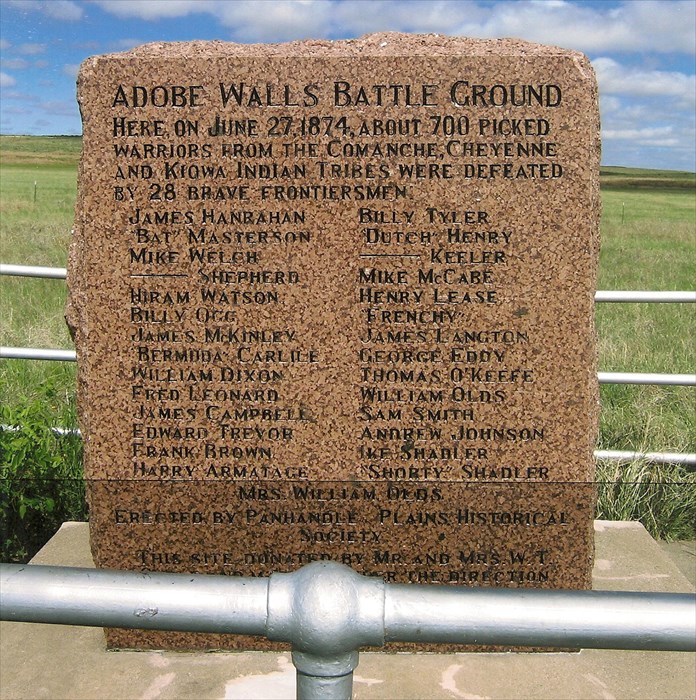June 2024 update.
There will be a sesquicentennial celebration on the anniversary of the Second Battle. Please go to last post for update.
To begin, most here probably know that Adobe Walls was the name of a trading post established in Hutchison County in 1843, and an adobe fort built in 1845. It was built by Bent and St. Vrain, of the famous Bent's Fort in Colorado. It was to be a trading post for the Comanches, but was blown up and abandoned for the last time in 1849, due to repeated Indian Attacks.
This site is not accessible. The later site, about a mile north, is the one detailed here.
It's about 15 miles ENE of Stinnett, but is 28 miles from there by car. The 5 acre site is owned by the Panhandle Historical Society, which runs the Panhandle Plains Historical Museum in Canyon. But it is within the historic Turkey Track Ranch, and you travel the last few miles there on one of their roads. The easement is granted by the current owners, and I hope the new owners will honor the easement, once it sells.
The road is mostly paved, with a few caliche sections. It's a good road, and can be done with all but the most low-slung 2WD cars. It's probably accessible in light rain, but I probably would not go if heavy rain is expected. If you appreciate farming, you pass several big, nice, farming operations on the road out.
The ruins of old post were the site of the largest Indian Battle fought during the Civil War, November 25, 1864. Kit Carson, and over 300 Union volunteers from Colorado, New Mexico, and California traveled down the Canadian River from Santa Fe and Fort Bascom, to punish the Indians who were raiding into New Mexico Territory. They were accompanied by around 70 Ute and Jicarilla Indian Scouts, and carried two mountain howitzers.
When they got to Adobe Walls, they found at least a thousand Indians, some accounts say as many as 7,000, engaged them in battle, and only escaped back to New Mexico by the grace of God and the Mountain Howitzers.
In 1874, with the buffalo numbers declining, hide hunters moved into Comancheria, to the last great hunting grounds. A new trading post, also built of adobe and sod, was set up about a mile from the ruins of the 1845 post. The Comanches and the other Southern Plains tribes took exception to this, and on June 27, 1874, about 700 of them, lead by Quanah Parker, attacked the 28 buffalo hunters in the fort. Among the hunters there were Bat Masterson, and Billy Dixon.
Google Maps showing the 85 mile drive from Amarillo:

There will be a sesquicentennial celebration on the anniversary of the Second Battle. Please go to last post for update.
To begin, most here probably know that Adobe Walls was the name of a trading post established in Hutchison County in 1843, and an adobe fort built in 1845. It was built by Bent and St. Vrain, of the famous Bent's Fort in Colorado. It was to be a trading post for the Comanches, but was blown up and abandoned for the last time in 1849, due to repeated Indian Attacks.
This site is not accessible. The later site, about a mile north, is the one detailed here.
It's about 15 miles ENE of Stinnett, but is 28 miles from there by car. The 5 acre site is owned by the Panhandle Historical Society, which runs the Panhandle Plains Historical Museum in Canyon. But it is within the historic Turkey Track Ranch, and you travel the last few miles there on one of their roads. The easement is granted by the current owners, and I hope the new owners will honor the easement, once it sells.
The road is mostly paved, with a few caliche sections. It's a good road, and can be done with all but the most low-slung 2WD cars. It's probably accessible in light rain, but I probably would not go if heavy rain is expected. If you appreciate farming, you pass several big, nice, farming operations on the road out.
The ruins of old post were the site of the largest Indian Battle fought during the Civil War, November 25, 1864. Kit Carson, and over 300 Union volunteers from Colorado, New Mexico, and California traveled down the Canadian River from Santa Fe and Fort Bascom, to punish the Indians who were raiding into New Mexico Territory. They were accompanied by around 70 Ute and Jicarilla Indian Scouts, and carried two mountain howitzers.
When they got to Adobe Walls, they found at least a thousand Indians, some accounts say as many as 7,000, engaged them in battle, and only escaped back to New Mexico by the grace of God and the Mountain Howitzers.
In 1874, with the buffalo numbers declining, hide hunters moved into Comancheria, to the last great hunting grounds. A new trading post, also built of adobe and sod, was set up about a mile from the ruins of the 1845 post. The Comanches and the other Southern Plains tribes took exception to this, and on June 27, 1874, about 700 of them, lead by Quanah Parker, attacked the 28 buffalo hunters in the fort. Among the hunters there were Bat Masterson, and Billy Dixon.
Google Maps showing the 85 mile drive from Amarillo:
























